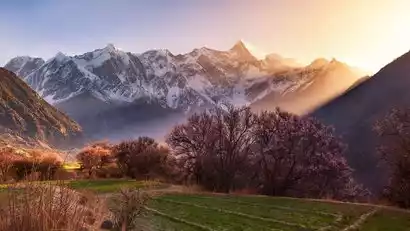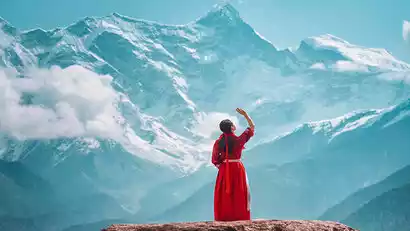Day 1: All over the country → Chengdu ★Assembly Day
All day
The first day is a full-day gathering day. Chengdu is one of the "Top Ten Tourist Cities in China". Tourists are advised to arrive as early as possible, stroll around, and experience the slow life of Chengdu among the various snacks and attractions.
Recommended places to visit: Jinli Ancient Street, Wuhou Temple, Kuanzhai Alley, and Chunxi Road, one of the top ten commercial streets in China.
Food recommendation: There are many Chengdu snacks in Jinli and Kuanzhai Alley: Long Chao Shou, Dandan Noodles, Feichangfen, and Maocai.


Day 2 Chengdu (500m) → Zheduo Mountain (4000m) → Kangding (2900m) → Yajiang (2800m)
·morning
After breakfast, drive along the Chengya Expressway to Ya'an, enjoy the scenery of the western Sichuan plain along the way, go up along the Dadu River Valley, pass the famous red city Luding County, and arrive at the horse-racing Kangding City.
Arriving in Kangding, we entered the Tibetan area, where Tibetan culture was evident everywhere. We continued driving, crossing the first high mountain on National Highway 318, the Zheduo Mountain Pass, and stopped for a photo under the prayer flags.
·night
Stay at the Yajiang County Hotel that night.


Day 3 Yajiang County (2900m) → Litang (4000m) → Renkang Ancient Street (4000m) → Haizi Mountain (4200m) → Shangri-La Town (2900m)
All day
We arrived in Litang, the "Sky City," Ding Zhen's hometown. His unexpected rise to fame has brought awareness to this forgotten gem of Ganzi. We then visited Letong Ancient Town, also known as Renkang Ancient Street, named after the Renkang Ancient House, the birthplace of the Seventh Dalai Lama. The street also boasts numerous unique miniature museums.
Proceed to visit Changqingchunkol Temple, also known as Litang Temple, which is a famous Yellow Sect temple of Tibetan Buddhism in Kang region and is known as the "Buddhist Holy Land in Southern Kang".
In Litang, we can also experience Tibetan incense making under the guidance of local people.
·afternoon
Embark on the beautiful Liya Road, admire the boundless Maoya grassland along the way, and cross the ancient glacier relics of the Qinghai-Tibet Plateau - the desolate, rugged and magnificent Haizi Mountain Nature Reserve. On clear days, you can also overlook the sacred Mount Genyen.
We arrived at Shangri-La Town in the evening. Looking up at night, we could see the brilliant starry sky on the plateau. Everyone, have a good rest. Tomorrow we will officially start our long-awaited trip to Daocheng Yading.


Day 4: Shangri-La Town (2900m) → Luorong Cattle Farm (4150m) (or Zhaguanbeng → Gongga Yinhe Valley → Luorong Cattle Farm)] Chonggu Temple (3500m) → Chonggu Meadow (3800m) → Pearl Cotso (4100m) → Shangri-La Town (2900m)
All day
After breakfast, take the scenic sightseeing bus to Chonggu Meadow again. Here, you can choose two ways to go to Luorong Ranch according to your own situation:
1. Walk to and return by car: Gongga Silver River Valley refers to the river valley from Chonggu Meadow to Luorong Cattle Farm, stretching approximately 6.5 kilometers and requiring a 2-3 hour walk one way. While most visitors choose to reach it by car, the canyon's scenery is truly stunning. Xianuoduoji Snow Mountain serves as a guiding light. As you turn a corner, the forest gives way to meadows, and the sacred Yangmaiyong Mountain suddenly appears in sight. The entire route is a plank road, offering gentle, resting, and photo opportunities, including vantage points for capturing Yangmaiyong's reflection. If you're not visiting the Milk Lake and have a good stamina, we highly recommend dedicating some time to this excursion!
2. Round trip by car: This is the method chosen by most tourists. If you just want to enjoy the slow time at Luolong Ranch, or decide to go to the Milk Sea, this method is more recommended.
Luorong Ranch is the central area of the Yading Scenic Area. You can take close-up photos of the two sacred mountains, Yangmaiyong and Xianuoduoji. The Gongga River flows through the pasture, and the gurgling stream in the forest complements the ranch cabins, creating a pristine and charming scenery. In the afternoon, we will depart the Yading Scenic Area and return to Shangri-La Town for overnight stay.
Warm reminder: Although the Milk Sea and the Five-Colored Sea are beautiful, the journey is long, the road conditions are poor, and the altitude is high (4,600 meters). Tourists are advised to proceed with caution and do what they can. You can enjoy the scenery later, but safety is always the first priority.


Day 5: Shangri-La Town (2900m) → Chonggu Grassland (3800m) → Pearl Tso (4100m) → Litang County
All day
After breakfast, we boarded a scenic shuttle bus and officially entered the Daocheng Yading Scenic Area. Driving along the winding mountain road, we unexpectedly saw Xiannairi and Xianuoduoji appear before our eyes at a turn, a truly stunning sight.
Arrive at Yading Village at the foot of the sacred mountain and take a shuttle bus to Zhaguanbeng. Then, follow the plank road to Chonggu Meadow. Meandering clear streams crisscross the alpine meadows, with the towering Xianuoduoji Mountain in the background. This is also the filming location for the romantic proposal scene in "Passing by Your World."
Listen to the Buddhist chants of Chonggu Temple, explore the little jasper [Pearl Co] in the alpine jungle, and see the sacred mountain Xiannairi reflected in the lake. If you are lucky, you can even get close to the foot of "Xiannairi", build a Mani pile yourself, and pay homage to the snow-capped mountain.
·night
Return to Shangri-La Town in the afternoon. Then proceed to Litang County for check-in (oxygen room arranged)


Day 6: Litang (4000m) → Visit Maoya Grassland → Batang County (2900m) → Mangkang (3600m)
·morning
Depart in the morning, see the scenery of Maoya Prairie, and stop at the famous Sister Lake for photos.
·afternoon
Check into the hotel in Mangkang County in the evening


Day 7 Mangkang County → Nujiang 72 turns → Zuogong County
All day
We set out early in the morning, crossed the Jinsha River Bridge, stepped over the Sichuan-Tibet Divide Line, and officially arrived in Tibet. Mangkam is the first county after entering Tibet, with an altitude of 3,780 meters. The Jinsha River, Lancang River and Nu River originate from the Tanggula Mountains in the Qinghai-Tibet Plateau. They flow in parallel within a range of nearly hundreds of kilometers in this area, forming the so-called "Three Rivers Sandwiched Between Two Walls" Sanjiang area.
After crossing the Dongda Mountain Pass at an altitude of 5008m, we stayed in Zuogong County that night. Our G318 Sichuan-Tibet Highway journey was already halfway through. We had already entered Tibet from Sichuan. Tourists could have a good rest and recharge their energy for the next journey in Tibet.
·night
Check into Zuogong County hotel that night.


Day 8 Zuogong County → Ranwu Town
All day
Afterwards, we passed through Zuogong County and Bangda Grassland, crossed the Yela Mountain and arrived at the famous [72 Turns of the Nujiang River] on the Sichuan-Tibet Highway. Along the way, we saw the Nujiang Grand Canyon and passed through Basu County. Basu means "the village at the foot of the Warrior Mountain" in Tibetan. Along the way, snow-capped mountains, virgin forests and pastoral scenery complemented each other. The beautiful scenery was a reward for our long journey.
·afternoon
In the evening, we stayed in Ranwu Town by the lake.
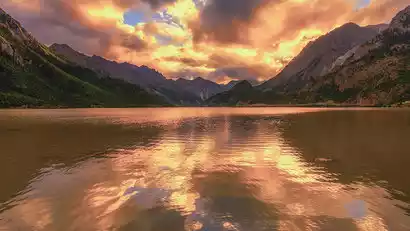
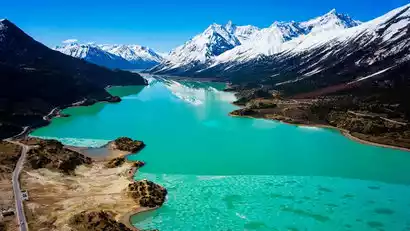
No. 9 Natural Wuzhen → Midui Glacier Bus] Lulang
·morning
After breakfast, we will set out westward to Ranwu Lake. Along the way, we will see lush trees, gurgling waters, circling eagles, and the stunning scenery of snow-capped mountains, lakes, farmlands, and villages. It will be overwhelming and intoxicating.
Ranwu Lake means "goat milk lake" in Tibetan. There are lush green pastures and lush green crops on the edge of Ranwu Lake, vast forests on the hillsides near the lake, colorful rhododendrons and shrubs further up, and the top of the mountain is covered with overlapping snow-capped mountains that never melt all year round.
·afternoon
In Lulang, we will give you a special gift of local specialty stone pot chicken. After enjoying the meal, you can walk through the Lulang forest and enjoy the folk villages, alpine meadows, and snow-capped mountain forests along the way.
Check into Lulang Hotel in the evening
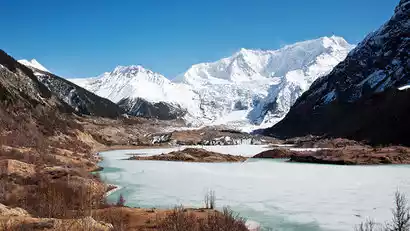
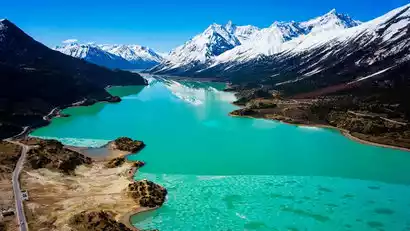
Day 10 Lulang → Nyingchi → Yarlung Zangbo Grand Canyon → Suosong Village
All day
We set off after getting up early and having breakfast, driving to the banks of the Yarlung Zangbo River. Here, the peach blossoms and willows are already green. We continue along the way and visit the confluence of the Niyang River and the Yarlung Zangbo River. We pray for good luck and get our first glimpse of Mount Namjagbarwa, which is 7,782 meters above sea level in the eastern section of the Himalayas.
We abandoned the usual boring sightseeing and headed straight for Suosong Village. This is one of the best viewing spots for photographing Mount Namjagbarwa and the Nyingchi peach blossoms. We strolled around the Tibetan houses and through the fields of the village. The still-lush ancient chestnut and peach trees carried centuries of stories and past events, and the gentle breeze from the ancient snow-capped mountains beside us evoked the tranquility of the village.
·afternoon
In the evening, you can encounter the golden mountain of Mount Namjagbarwa in the sunlight. At night, if the weather is clear, you can also see the magnificent Milky Way arch bridge.
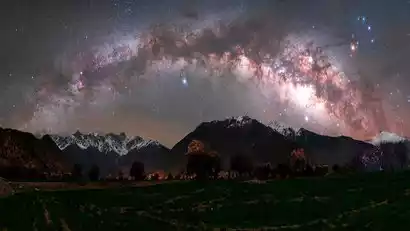
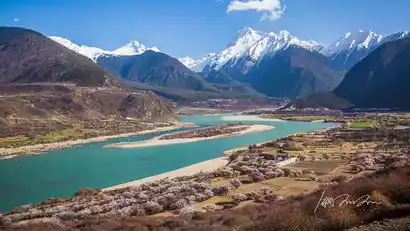
Day 11: Suosong Village → Disband in Lhasa
·morning
Tourists who rise early today can arrange their own activities to watch the sunrise over Mount Namjagbarwa and Mount Doxiong La. Suosong Village is also a fantastic spot for photographing the snow-capped mountains. The Yarlung Zangbo River surges through the valley, and the scenery is breathtakingly beautiful, with crimson leaves and colorful trees lining the valley. The village is sparsely populated, with its barley fields and wild peach trees complementing each other.
·morning
We will gather and depart for the holy city of Lhasa. We will disband in the city of Lhasa. Since we arrive in Lhasa late today, we recommend you stay in Lhasa for one night and continue to play in Lhasa for a few days.
